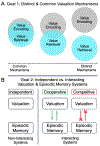Value network engagement and effects of memory-related processing during encoding and retrieval of value
- PMID: 34052683
- PMCID: PMC8489736
- DOI: 10.1016/j.bandc.2021.105754
Value network engagement and effects of memory-related processing during encoding and retrieval of value
Abstract
Decision makers rely on episodic memory to calculate choice values in everyday life, yet it is unclear how neural mechanisms of valuation differ when value-related information is encoded versus retrieved from episodic memory. The current fMRI study compared neural correlates of value while information was encoded versus retrieved from memory. Scanned tasks were followed by a behavioral episodic memory test for item-attribute associations. Our analyses sought to (i) identify neural correlates of value that were distinct and common across encoding and retrieval, and (ii) determine whether neural mechanisms of valuation and episodic memory interact. The study yielded three primary findings. First, value-related activation in the fronto-striatal reward circuit and posterior parietal cortex was comparable across valuation phases. Second, value-related activation in select fronto-parietal and salience regions was significantly greater at value retrieval than encoding. Third, there was no interaction between neural correlates of valuation and episodic memory. Taken with prior research, the present study indicates that fronto-parietal and salience regions play a key role in retrieval-dependent valuation and context-specific effects likely determine whether neural correlates of value interact with episodic memory.
Keywords: Decision making; Encoding; Episodic memory; Retrieval; Value network; fMRI.
Copyright © 2021 Elsevier Inc. All rights reserved.
Conflict of interest statement
Declaration of competing interest
The authors declare no competing financial interests.
Figures






Similar articles
-
Menopause Status and Within-Group Differences in Chronological Age Affect the Functional Neural Correlates of Spatial Context Memory in Middle-Aged Females.J Neurosci. 2023 Dec 13;43(50):8756-8768. doi: 10.1523/JNEUROSCI.0663-23.2023. J Neurosci. 2023. PMID: 37903593 Free PMC article.
-
Dynamic changes in large-scale functional network organization during autobiographical memory retrieval.Neuropsychologia. 2018 Feb;110:208-224. doi: 10.1016/j.neuropsychologia.2017.09.020. Epub 2017 Sep 23. Neuropsychologia. 2018. PMID: 28951163
-
Neural substrates of long-term item and source memory for emotional associates: An fMRI study.Neuropsychologia. 2020 Oct;147:107561. doi: 10.1016/j.neuropsychologia.2020.107561. Epub 2020 Jul 23. Neuropsychologia. 2020. PMID: 32712148
-
Top-down and bottom-up attention to memory: a hypothesis (AtoM) on the role of the posterior parietal cortex in memory retrieval.Neuropsychologia. 2008;46(7):1828-51. doi: 10.1016/j.neuropsychologia.2008.03.022. Epub 2008 Apr 8. Neuropsychologia. 2008. PMID: 18471837 Review.
-
Ventral lateral parietal cortex and episodic memory retrieval.Cortex. 2018 Oct;107:238-250. doi: 10.1016/j.cortex.2017.07.012. Epub 2017 Jul 25. Cortex. 2018. PMID: 28802589 Free PMC article. Review.
References
-
- Bhui R (2018). Case-based decision neuroscience: Economic judgment by similarity. In Morris RW, Bornstein AM, & Shenhav A (Eds.), Goal-directed decision making: Computations and neural circuits (pp. 67–103). Elsevier Academic Press. doi:10.1016/b978-0-12-812098-9.00004-8 - DOI
Publication types
MeSH terms
Grants and funding
LinkOut - more resources
Full Text Sources
Other Literature Sources

